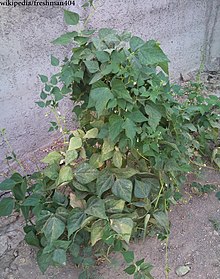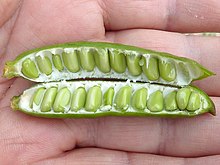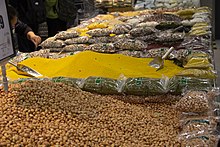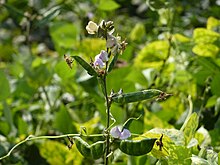Bean


Abeanis the seed of several plants in the familyFabaceae,which are used asvegetablesfor human or animal food.[1]They can be cooked in many different ways,[2]including boiling, frying, and baking, and are used in many traditional dishes throughout the world.
Terminology
The word "bean" and its Germaniccognates(e.g.GermanBohne) have existed in common use inWest Germanic languagessince before the 12th century,[3]referring tobroad beans,chickpeas,and other pod-borne seeds. This was long before theNew WorldgenusPhaseoluswas known in Europe. With theColumbian exchangeof domestic plants between Europe and the Americas, use of the word was extended to pod-borne seeds ofPhaseolus,such as thecommon beanand therunner bean,and the related genusVigna.The term has long been applied generally to many other seeds of similar form,[3][4]such as Old Worldsoybeans,peas,othervetches,andlupins,and even to those with slighter resemblances, such ascoffee beans,vanilla beans,castor beans,andcocoa beans.Thus the term "bean" in generalusagecan refer to a host of different species.[5]
Seeds called "beans" are often included among the crops called "pulses" (legumes),[3]although the words are not always interchangeable (usage varies by plant variety and by region). Both terms,beansandpulses,are usually reserved for grain crops and thus exclude those legumes that have tiny seeds and are used exclusively for non-grain purposes (forage,hay,andsilage), such ascloverandalfalfa.The United NationsFood and Agriculture Organizationdefines "BEANS, DRY" (item code 176)[5]as applicable only to species ofPhaseolus.This is one of various examples of how narrowerword sensesenforced intrade regulationsorbotanyoften coexist innatural languagewith broadersensesinculinary use and general use;other common examples arethe narrow sense of the wordnutand thebroader sense of the wordnut,and the fact thattomatoes are fruit, botanically speaking, but are often treated as vegetables in culinary and general usage.Relatedly, another detail of usage is that several species of plants that are sometimes called beans, includingVigna angularis(azuki bean),mungo(black gram),radiata(green gram), andaconitifolia(moth bean), were onceclassifiedasPhaseolusbut later reclassified—but the taxonomic revision does not entirely stop the use of well-established senses in general usage.
Cultivation

Unlike the closely relatedpea,beans are a summer crop that needs warm temperatures to grow. Legumes are capable ofnitrogen fixationand hence need less fertiliser than most plants. Maturity is typically 55–60 days from planting to harvest.[6]As the bean pods mature, they turn yellow and dry up, and the beans inside change from green to theirmature colourthat they have when fully ripe. Many beans arevines,as such the plants need external support, which may take the form of special "bean cages" or poles. Native Americans customarily grew them along with corn and squash (the so-calledThree Sisters),[7]with the tallcornstalksacting as support for the beans.
In more recent times, the so-called "bush bean" has been developed which does not require support and has all its pods develop simultaneously (as opposed to pole beans which develop gradually).[8]This makes the bush bean more practical for commercial production.
History
This sectionneeds additional citations forverification.(April 2022) |



Beans were an important source ofproteinthroughout Old and New World history, and still are today.
Beans are one of the longest-cultivated plants in history.Broad beans,also called fava beans, are in their wild state the size of a small fingernail, and were first gathered inAfghanistanand the Himalayan foothills.[9]An early cultivated form were grown in Thailand from the early seventh millennium BCE, predating ceramics.[10]Beans were deposited with the dead inancient Egypt.Not until the second millennium BCE did cultivated, large-seeded broad beans appear in theAegean region,Iberia,and transalpine Europe.[11]In theIliad(8th century BCE), there is a passing mention of beans andchickpeascast on the threshing floor.[12]
The oldest-known domesticated beans in the Americas were found inGuitarrero Cave,an archaeological site inPeru,and dated to around the second millennium BCE.[13]Genetic analyses of the common beanPhaseolusshow that it originated inMesoamerica,and subsequently spread southward, along withmaizeand squash, traditional companion crops.[14]
Most of the kinds of beans commonly eaten today are part of the genusPhaseolus,which originated in the Americas. The first European to encounter them wasChristopher Columbus,while exploring what may have been theBahamas,and saw them growing in fields. Five kinds ofPhaseolusbeans were domesticated[15]by pre-Columbian peoples: common beans (P. vulgaris) grown from Chile to the northern part of what is now the United States; and lima and sieva beans (P. lunatus); as well as the less widely distributed teparies (P. acutifolius), scarlet runner beans (P. coccineus), and polyanthus beans.[16]
One well-documented use of beans bypre-Columbianpeople as far north as the Atlantic seaboard is the "Three Sisters"method ofcompanion plantcultivation: Many tribes would grow beans together with maize or "corn", andsquash.The corn would not be planted in rows as is done by European agriculture, but in a checkerboard/hex fashion across a field, in separate patches of one to six stalks each. Beans would be planted around the base of the developing stalks, and would vine their way up as the stalks grew. All American beans at that time were vine plants; "bush beans" were cultivated more recently. The cornstalks would work as atrellisfor the bean plants, and the beans would provide much-needednitrogenfor the corn. Squash would be planted in the spaces between the patches of corn in the field. They would be provided slight shelter from the sun by the corn, would shade the soil and reduce evaporation, and would deter many animals from attacking the corn and beans because their coarse, hairy vines and broad, stiff leaves are difficult or uncomfortable for animals such as deer and raccoons to walk through, crows to land on, and are a deterrent to other animals as well.
Beans were cultivated across Chile in Pre-Hispanic times, likely as far south asChiloé Archipelago.[17]
Dry beans come from both Old World varieties of broad beans (fava beans) and New World varieties (kidney, black, cranberry, pinto, navy/haricot).
Common genera and species

Most of the foods we call "beans", "legumes","lentils "and" pulses "belong to the same family,Fabaceae( "leguminous" plants), but are from different genera and species, native to different homelands and distributed worldwide depending on their adaptability.[18]Many varieties are eaten both fresh (the whole pod, and the immature beans may or may not be inside) or shelled (immature seeds, mature and fresh seeds, or mature and dried seeds). Numerous legumes look similar, and have become naturalized in locations across the world, which often lead to similar names for different species.
| Genus | Species and Common Varieties | Probable Homeland | Distribution, Cultivation and Climate | Notes |
|---|---|---|---|---|
| Phaseolus | P. vulgaris:Kidney Bean,Pinto Bean,Navy Bean(Cannellini, Haricot Beans/French Beans/Pole Beans/Bush Beans),Black Beans,Borlotti Beans
P. lunatus:Lima Beans P. coccineus:Runner Beans, Flat Beans P. acutifolius:Tepary Bean |
The Americas | Tropical,Subtropical,Warm Temperate | Certain varieties contain high levels of toxicphytohemagglutinin.Requires soaking and then cooking at or above 100C for a minimum of 30 minutes, and ideally much longer.[19][20][21] |
| Pisum | P. sativum:Green Peas/Garden Peas, White Peas, Yellow Peas, Field Peas,Snow Peas,Snap Peas | Mediterranean | Subtropical, Temperate, Occasionally Cool Tropical | |
| Vigna | V. radiata:Mung Bean
V. mungo:Urad V. unguiculata (Cowpeas):Yardlong bean, Black-eyed Peas V. aconitifolia:Moth bean V. angularis:Adzuki beans |
MostlySouth Asia | Equatorial, Pantropical, Warm Subtropical, Hot Temperate | |
| Cajanus | C. cajan:Pigeon Pea | Indian Subcontinent | Pantropical,Equatorial | |
| Lens | L. culinaris(Lentils): Red Lentil, Green Lentil, Puy Lentil | Near East/Levant | Temperate, Subtropical, Cool Tropical | |
| Cicer | C. arietinum:Chickpeas (Garbanzo Beans) | Turkey/Levant/Near East | Temperate, Subtropical, Cool Tropical | |
| Vicia | V. faba:Fava Beans (Broad Beans)
V. ervilia:Bitter vetch V. sativa:Common vetch |
Near East | Subtropical, Temperate | CausesFavismin those susceptible.[22][23] |
| Arachis | A. hypogaea:Peanut (Groundnut) | South America | Warm Subtropical, Cool Tropical | |
| Glycine | G. max:Soybean | East Asia | Hot Temperate, Subtropical, Cool Tropical | |
| Macrotyloma | M. uniflorum:Horsegram | South Asia | Tropical, Subtropical | |
| Mucuna | M. pruriens:Velvet Bean | Tropical Asia andAfrica | Tropical, Warm Subtropical | ContainsL-DOPA,[24]and smaller amounts of other psychoactive compounds. Can also cause itching and rashes on contact. |
| Lupinus | L. albus:White Lupin
L. mutabilis:Tarwi/Andean Lupin |
The Mediterranean,Balkans,Levant (albinus),The Andes(mutabilis) | Subtropical, Temperate | Requires prolonged soaking in the correct way to reduce toxic compounds.[25] |
| Ceratonia | C. siliqua:Carob bean | Mediterranean,Middle East | Subtropical, Arid Subtropical, Hot Temperate | |
| Canavalia | C. gladiata:Sword Bean
C. ensiformis:Jack Beans |
South Asia or Africa (C. gladiata),Braziland South America (C. Ensiformis) | Tropical | |
| Cyamopsis | C. tetragonoloba:Guar Bean | Africa or South Asia | Tropical, Semi-Arid | Source ofGuar gum |
| Lablab | L. purpureus:Hyacinth Bean/Lablab Bean | South Asia, Indian Subcontinent or Africa | Tropical | |
| Psophocarpus | P. tetranoglobulus:Winged Bean | New Guinea | Tropical,Equatorial | |
| Clitoria | C. ternatea:Butterfly Pea | Equatorial and Tropical Asia | Tropical, Subtropical | Flowers used as anatural food colouring |
| Lathyrus | L. sativus:Grass Pea
L. tuberosus:Tuberous Pea |
Balkans, India or Asia | Subtropical | Can causeLathyrismif used as staple.[26][27] |
| Trifolium | T. repens:White Clover
T. pratense:Red Clover |
EuropeandCentral Asia | Subtropical, Temperate | |
| Medicago | M. sativa:Alfalfa | Central Asia | Subtropical, Temperate | |
| Melilotus | M. officinalis:Sweet Clover | Europe and Central Asia | Subtropical, Temperate | ContainsCoumarins,an important class ofperfumeingredients. Coumarin is also a blood thinner. |
| Tamarindus | T. indica:Tamarind | Africa | Tropical, Subtropical |
Bean seed storage
As of 2023, the NorwegianSvalbard Global Seed Vaultholds more than 40,000accessionsofPhaseolusbean species.[28]
Properties
Nutrition
| Nutritional value per 100 g (3.5 oz) | |
|---|---|
| Energy | 31 kcal (130 kJ) |
6.97 g | |
| Sugars | 3.26 g |
| Dietary fiber | 2.7 g |
0.22 g | |
1.83 g | |
| Vitamins | Quantity %DV† |
| Thiamine (B1) | 7% 0.082 mg |
| Riboflavin (B2) | 8% 0.104 mg |
| Niacin (B3) | 5% 0.734 mg |
| Vitamin B6 | 8% 0.141 mg |
| Folate (B9) | 8% 33 μg |
| Vitamin C | 14% 12.2 mg |
| Minerals | Quantity %DV† |
| Calcium | 3% 37 mg |
| Iron | 6% 1.03 mg |
| Magnesium | 6% 25 mg |
| Phosphorus | 3% 38 mg |
| Potassium | 7% 211 mg |
| Sodium | 0% 6 mg |
| Zinc | 2% 0.24 mg |
| Other constituents | Quantity |
| Water | 90.3 g |
| †Percentages estimated usingUS recommendationsfor adults,[29]except for potassium, which is estimated based on expert recommendation fromthe National Academies.[30] | |
Raw green beans are 90% water, 7%carbohydrates,2%protein,and contain negligiblefat(table). In a 100 grams (3.5 oz) reference serving, raw green beans supply 31caloriesoffood energy,and are a moderate source (10-19% of theDaily Value,DV) ofvitamin C(15% DV) andvitamin B6(11% DV), with no othermicronutrientsin significant content (table).
Antinutrients
Many types of bean like kidney bean contain significant amounts ofantinutrientsthat inhibit some enzyme processes in the body.Phytic acidand phytates, present in grains, nuts, seeds and beans, interfere with bone growth and interruptvitamin Dmetabolism. Pioneering work on the effect of phytic acid was done byEdward Mellanbyfrom 1939.[31][32]
Health concerns
Toxins
Some kinds of raw beans contain a harmful, tasteless toxin: thelectinphytohaemagglutinin,which must be removed by cooking. Redkidney beansare particularly toxic, but other types also pose risks offood poisoning.Even small quantities (4 or 5 raw beans) may cause severe stomachache, vomiting, and diarrhea. This risk does not apply to canned beans because they have already been cooked.[33]A recommended method is to boil the beans for at least ten minutes; under-cooked beans may be more toxic than raw beans.[34]
Cooking beans, without bringing them to a boil, in aslow cookerat a temperature well below boiling may not destroy toxins.[34]A case of poisoning bybutter beansused to makefalafelwas reported; the beans were used instead of traditionalbroad beansorchickpeas,soaked and ground without boiling, made into patties, andshallow fried.[35]
Bean poisoning is not well known in the medical community, and many cases may be misdiagnosed or never reported; figures appear not to be available. In the case of the UKNational Poisons Information Service,available only to health professionals, the dangers of beans other than red beans were not flagged as of 2008[update].[35]
Fermentationis used in some parts of Africa to improve the nutritional value of beans by removing toxins. Inexpensive fermentation improves the nutritional impact of flour from dry beans and improves digestibility, according to research co-authored by Emire Shimelis, from the Food Engineering Program at Addis Ababa University.[36]Beans are a major source of dietaryproteinin Kenya, Malawi, Tanzania, Uganda and Zambia.[37]
Bacterial infection from bean sprouts
It is common to makebeansproutsby letting some types of bean, oftenmung beans,germinate in moist and warm conditions; beansprouts may be used as ingredients in cooked dishes, or eaten raw or lightly cooked. There have been manyoutbreaks of diseasefrom bacterial contamination, often bysalmonella,listeria,andEscherichia coli,of beansprouts not thoroughly cooked,[38]some causing significant mortality.[39]
Flatulence
Many edible beans, including broad beans, navy beans, kidney beans and soybeans, containoligosaccharides(particularlyraffinoseandstachyose), a type of sugar molecule also found incabbage.An anti-oligosaccharideenzymeis necessary to properly digest these sugar molecules. As a normal human digestive tract does not contain any anti-oligosaccharide enzymes, consumed oligosaccharides are typically digested bybacteriain the large intestine. This digestion process produces gases, such as methane as a byproduct, which are then released asflatulence.[40][41][42][43]
Production

The production data for legumes are published byFAOin three categories:
- Pulses dry: all mature and dry seeds of leguminous plants except soybeans and groundnuts.
- Oil crops: soybeans and groundnuts.
- Fresh vegetable: immature green fresh fruits of leguminous plants.
The following is a summary of FAO data.[44]
| Crops [FAO code][45] |
1961 | 1981 | 2001 | 2015 | 2016 | Ratio 2016 /1961 |
Remarks |
|---|---|---|---|---|---|---|---|
| Total pulses (dry) [1726] | 40.78 | 41.63 | 56.23 | 77.57 | 81.80 | 2.01 | Per capita production had decreased. (Population increase was 2.4×) |
| Oil crops (dry) | |||||||
| Soybeans [236] | 26.88 | 88.53 | 177.02 | 323.20 | 334.89 | 12.46 | Drastic increase driven by the demand for animal feeds and oil. |
| Groundnuts, with shell [242] | 14.13 | 20.58 | 35.82 | 45.08 | 43.98 | 3.11 | |
| Fresh vegetables (80–90% water) | |||||||
| Beans, green [414] | 2.63 | 4.09 | 10.92 | 23.12 | 23.60 | 8.96 | |
| Peas, green [417] | 3.79 | 5.66 | 12.41 | 19.44 | 19.88 | 5.25 | |
Main crops of "Pulses, Total (dry)" are "Beans, dry [176]" 26.83 million tons, "Peas, dry [187]" 14.36 million tons, "Chick peas [191]" 12.09 million tons, "Cow peas [195]" 6.99 million tons, "Lentils [201]" 6.32 million tons, "Pigeon peas [197]" 4.49 million tons, "Broad beans, horse beans [181]" 4.46 million tons. In general, the consumption of pulses per capita has been decreasing since 1961. Exceptions are lentils and cowpeas.

| Country | 2016 | Share | Remarks | |
|---|---|---|---|---|
| Total | 81.80 | 100% | ||
| 1 | India | 17.56 | 21.47% | |
| 2 | Canada | 8.20 | 10.03% | |
| 3 | Myanmar | 6.57 | 8.03% | |
| 4 | China | 4.23 | 5.17% | |
| 5 | Nigeria | 3.09 | 3.78% | |
| 6 | Russia | 2.94 | 3.60% | |
| 7 | Ethiopia | 2.73 | 3.34% | |
| 8 | Brazil | 2.62 | 3.21% | |
| 9 | Australia | 2.52 | 3.09% | |
| 10 | USA | 2.44 | 2.98% | |
| 11 | Niger | 2.06 | 2.51% | |
| 12 | Tanzania | 2.00 | 2.45% | |
| Others | 24.82 | 30.34% |
The world leader in production of dry beans (Phaseolusspp),[47]is India, followed by Myanmar (Burma) and Brazil. In Africa, the most important producer is Tanzania.[48]
| Country | Production (tonnes) |
Footnote |
|---|---|---|
| 5,460,000 | F | |
| 3,053,012 | ||
| 3,035,290 | A | |
| 1,495,180 | * | |
| 1,281,586 | ||
| 1,267,648 | F | |
| 1,056,071 | ||
| 774,366 | F | |
| 633,823 | * | |
| 603,980 | ||
| World | 27,545,942 | A |
No symbol = official figure, P = official figure, F = FAO estimate, * = unofficial/semi-official/mirror data, C = calculated figure A = aggregate (may include official, semi-official or estimates)
Source:UN Food and Agriculture Organization(FAO)[49]
See also
- Baked beans
- Jelly beans
- Mexican jumping bean
- List of bean soups
- Fassoulada– a bean soup
- List of edible seeds
- List of legume dishes
- Beans, Beans, the Musical Fruit
References
- ^"Beans and peas are unique foods | ChooseMyPlate".choosemyplate.gov.Retrieved24 January2020.
- ^Clark, Mellisa."How to Cook Beans".New York Times Cooking.Retrieved3 January2020.
- ^abcMerriam-Webster,Merriam-Webster's Collegiate Dictionary,Merriam-Webster, archived fromthe originalon 10 October 2020,retrieved3 May2016[page needed]
- ^Houghton Mifflin Harcourt,The American Heritage Dictionary of the English Language,Houghton Mifflin Harcourt, archived fromthe originalon 25 September 2015,retrieved3 May2016.
- ^ab"Definition And Classification Of Commodities (See Chapter 4)".FAO, United Nations. 1994. Archived fromthe originalon 12 October 2018.Retrieved5 July2012.
- ^Shurtleff, William; Aoyagi, Akiko (1 October 2013).Early Named Soybean Varieties in the United States and Canada: Extensively Annotated Bibliography and Sourcebook.Soyinfo Center.ISBN9781928914600.Retrieved18 November2017– via Google Books.
- ^Schneider, Meg.New York Yesterday & Today.Voyageur Press.ISBN9781616731267.Retrieved18 November2017– via Google Books.
- ^"The Germination Of a Bean"(PDF).Microscopy-uk.org.uk.Archived(PDF)from the original on 9 October 2022.Retrieved18 November2017.
- ^Kaplan, pp. 27 ff
- ^Gorman, CF (1969). "Hoabinhian: A pebble-tool complex with early plant associations in southeast Asia".Science.163(3868): 671–3.Bibcode:1969Sci...163..671G.doi:10.1126/science.163.3868.671.PMID17742735.S2CID34052655.
- ^Daniel Zohary and Maria HopfDomestication of Plants in the Old WorldOxford University Press, 2012,ISBN0199549060,p. 114.
- ^"And as in some great threshing-floor go leaping From a broad pan the black-skinned beans or peas." (Iliadxiii, 589).
- ^Chazan, Michael (2008).World Prehistory and Archaeology: Pathways through Time.Pearson Education, Inc.ISBN978-0-205-40621-0.
- ^Bitocchi, Elena; Nanni, Laura; Bellucci, Elisa; Rossi, Monica; Giardini, Alessandro; Zeuli, Pierluigi Spagnoletti; Logozzo, Giuseppina; Stougaard, Jens; McClean, Phillip; Attene, Giovanna; Papa, Roberto (3 April 2012)."Mesoamerican origin of the common bean (Phaseolus vulgaris L.) is revealed by sequence data".Proceedings of the National Academy of Sciences.109(14): E788–E796.doi:10.1073/pnas.1108973109.PMC3325731.PMID22393017.
- ^Kaplan, p. 30: Domestication, besides involving selection for larger seed size, also involved selection for pods that did not curl and open when ripe, scattering the beans they contained.
- ^Kaplan, p. 30
- ^Pardo B., Oriana; Pizarro, José Luis (2014).Chile: Plantas alimentarias Prehispánicas(in Spanish) (2015 ed.).Arica,Chile: Ediciones Parina. p. 162.ISBN9789569120022.
- ^Boston, 677 Huntington Avenue; Ma 02115 +1495‑1000 (28 October 2019)."Legumes and Pulses".The Nutrition Source.Retrieved7 April2022.
{{cite web}}:CS1 maint: numeric names: authors list (link) - ^Nyombaire, G.; Siddiq, M.; Dolan, K. (2007)."Effect of soaking and cooking on the oligosaccharides and lectins of red kidney beans (Phaseolus vulgaris L.)".Annual Report.ISSN0084-7747.
- ^Nciri, Nader; Cho, Namjun (15 December 2017)."New research highlights: Impact of chronic ingestion of white kidney beans (Phaseolus vulgaris L. var. Beldia) on small-intestinal disaccharidase activity in Wistar rats".Toxicology Reports.5:46–55.doi:10.1016/j.toxrep.2017.12.016.ISSN2214-7500.PMC5735304.PMID29270365.
- ^Sun, Yufeng; Liu, Jiameng; Huang, Yatao; Li, Minmin; Lu, Jia; Jin, Nuo; He, Yan; Fan, Bei (1 January 2019)."Phytohemagglutinin content in fresh kidney bean in China".International Journal of Food Properties.22(1): 405–413.doi:10.1080/10942912.2019.1590399.ISSN1094-2912.
- ^Belsey, Mark A. (1973)."The epidemiology of favism".Bulletin of the World Health Organization.48(1): 1–13.ISSN0042-9686.PMC2481045.PMID4541143.
- ^Tarhani, Fariba; Nezami, Alireza; Heidari, Ghobad; Abdolkarimi, Babak (18 August 2020)."Clinical Manifestations and Therapeutic Findings of the Children with Glucose-6-Phosphate Dehydrogenase Deficiency Presenting Favism".Endocrine, Metabolic & Immune Disorders Drug Targets.21(6): 1125–1129.doi:10.2174/1871530320999200818182905.ISSN2212-3873.PMID32811422.S2CID221182334.
- ^Raina, Archana P.; Khatri, Renu (2011)."Quantitative Determination of L-DOPA in Seeds of Mucuna Pruriens Germplasm by High Performance Thin Layer Chromatography".Indian Journal of Pharmaceutical Sciences.73(4): 459–462.doi:10.4103/0250-474X.95651(inactive 31 January 2024).ISSN0250-474X.PMC3374567.PMID22707835.
{{cite journal}}:CS1 maint: DOI inactive as of January 2024 (link) - ^Schrenk, Dieter; Bodin, Laurent; Chipman, James Kevin; del Mazo, Jesús; Grasl-Kraupp, Bettina; Hogstrand, Christer; Hoogenboom, Laurentius (Ron); Leblanc, Jean-Charles; Nebbia, Carlo Stefano; Nielsen, Elsa; Ntzani, Evangelia (5 November 2019)."Scientific opinion on the risks for animal and human health related to the presence of quinolizidine alkaloids in feed and food, in particular in lupins and lupin-derived products".EFSA Journal.17(11): e05860.doi:10.2903/j.efsa.2019.5860.ISSN1831-4732.PMC7008800.PMID32626161.
- ^Haque, A.; Hossain, M.; Wouters, G.; Lambein, F. (1996)."Epidemiological Study of Lathyrism in Northwestern Districts of Bangladesh".Neuroepidemiology.15(2): 83–91.doi:10.1159/000109893.ISSN0251-5350.PMID8684587.
- ^Jahan, K.; Ahmad, K. (February 1993)."Studies on neurolathyrism".Environmental Research.60(2): 259–266.Bibcode:1993ER.....60..259J.doi:10.1006/enrs.1993.1035.ISSN0013-9351.PMID8472656.
- ^"The seeds".Svalbard Global Seed Vault, Norwegian Ministry of Agriculture and Food. 2023.Retrieved5 November2023.
- ^United States Food and Drug Administration(2024)."Daily Value on the Nutrition and Supplement Facts Labels".FDA.Archivedfrom the original on 27 March 2024.Retrieved28 March2024.
- ^National Academies of Sciences, Engineering, and Medicine; Health and Medicine Division; Food and Nutrition Board; Committee to Review the Dietary Reference Intakes for Sodium and Potassium (2019). Oria, Maria; Harrison, Meghan; Stallings, Virginia A. (eds.).Dietary Reference Intakes for Sodium and Potassium.The National Academies Collection: Reports funded by National Institutes of Health. Washington, DC: National Academies Press (US).ISBN978-0-309-48834-1.PMID30844154.Archivedfrom the original on 9 May 2024.Retrieved21 June2024.
- ^Harrison, DC; Mellanby, E (October 1939)."Phytic acid and the rickets-producing action of cereals".Biochem. J.33(10): 1660–1680.1.doi:10.1042/bj0331660.PMC1264631.PMID16747083.
- ^Ramiel Nagel (26 March 2010)."Living With Phytic Acid - Weston A Price".The Weston A Price Foundation.Retrieved23 January2016.
- ^"Natural toxins in food".who.int.Retrieved7 April2022.
- ^ab"Foodborne Pathogenic Microorganisms and Natural Toxins Handbook: Phytohaemagglutinin".Bad Bug Book.United StatesFood and Drug Administration.Archivedfrom the original on 9 July 2009.Retrieved11 July2009.
- ^abVicky Jones (15 September 2008)."Beware of the beans: How beans can be a surprising source of food poisoning".The Independent.Retrieved23 January2016.
- ^Shimelis, Emire Admassu; Rakshit, Sudip Kumar (2008). "Influence of natural and controlled fermentations on α-galactosides, antinutrients and protein digestibility of beans (Phaseolus vulgaris L.)".International Journal of Food Science & Technology.43(4): 658–665.doi:10.1111/j.1365-2621.2006.01506.x.ISSN1365-2621.
- ^Summary:Fermentation 'improves nutritional value of beans'Archived22 May 2013 at theWayback Machine(Sub Saharan Africa page, Science and Development Network website). Paper:Influence of natural and controlled fermentations on α-galactosides, antinutrients and protein digestibility of beans (Phaseolus vulgaris L.)
- ^"Sprouts: What You Should Know".Foodsafety.gov.Retrieved23 January2016.
- ^"Shiga toxin-producing E. coli (STEC): Update on outbreak in the EU (27 July 2011, 11:00)".European Centre for Disease Prevention and Control.27 July 2011. Archived fromthe originalon 15 March 2017.
- ^"Health | Experts make flatulence-free bean".BBC News.25 April 2006.Archivedfrom the original on 31 March 2009.Retrieved25 February2009.
- ^"Flatulence – Overview – Introduction".Nhs.uk.Archivedfrom the original on 21 February 2009.Retrieved25 February2009.
- ^Harold McGee (2003).Food and Cooking.Simon & Schuster. p. 486.ISBN978-0684843285.
Many legumes, especially soy, navy and lima beans, cause a sudden increase in bacterial activity and gas production a few hours after they're consumed. This is because they contain large amounts of carbohydrates that human digestive enzymes can't convert into absorbable sugars. These carbohydrates therefore leave the upper intestine unchanged and enter the lower reaches, where our resident bacterial population does the job we are unable to do.
- ^Peter Barham (2001).The Science of Cooking.Springer. p.14.ISBN978-3-540-67466-5.
we do not possess any enzymes that are capable of breaking down larger sugars, such as raffinose etc. These 3, 4 and 5 ring sugars are made by plants especially as part of the energy storage system in seeds and beans. If these sugars are ingested, they can't be broken down in the intestines; rather, they travel into the colon, where various bacteria digest them – and in the process produce copious amounts of carbon dioxide gas
- ^FAO STATProduction/Crops.
- ^SeeLegume § Classification.
- ^All legumes dry.
- ^Dry beans does not include broad beans, dry peas, chickpea, lentil.
- ^FAOPulses and Derived ProductsArchived7 December 2015 at theWayback Machine.
- ^"Major Food And Agricultural Commodities And Producers – Countries By Commodity".Fao.org. Archived fromthe originalon 6 September 2015.Retrieved2 February2015.
Bibliography
- Kaplan, Lawrence (2008)."Legumes in the History of Human Nutrition".In DuBois, Christine; Tan, Chee-Beng; Mintz, Sidney (eds.).The World of Soy.NUS Press. pp. 27–.ISBN978-9971-69-413-5.Retrieved18 December2012.
External links
- Everett H. Bickley Collection, 1919–1980Archives Center, National Museum of American History, Smithsonian Institution.
- Discovery Online: The Skinny On Why Beans Give You Gas
- Fermentation improves nutritional value of beans
- Cook's Thesaurus on Beans
